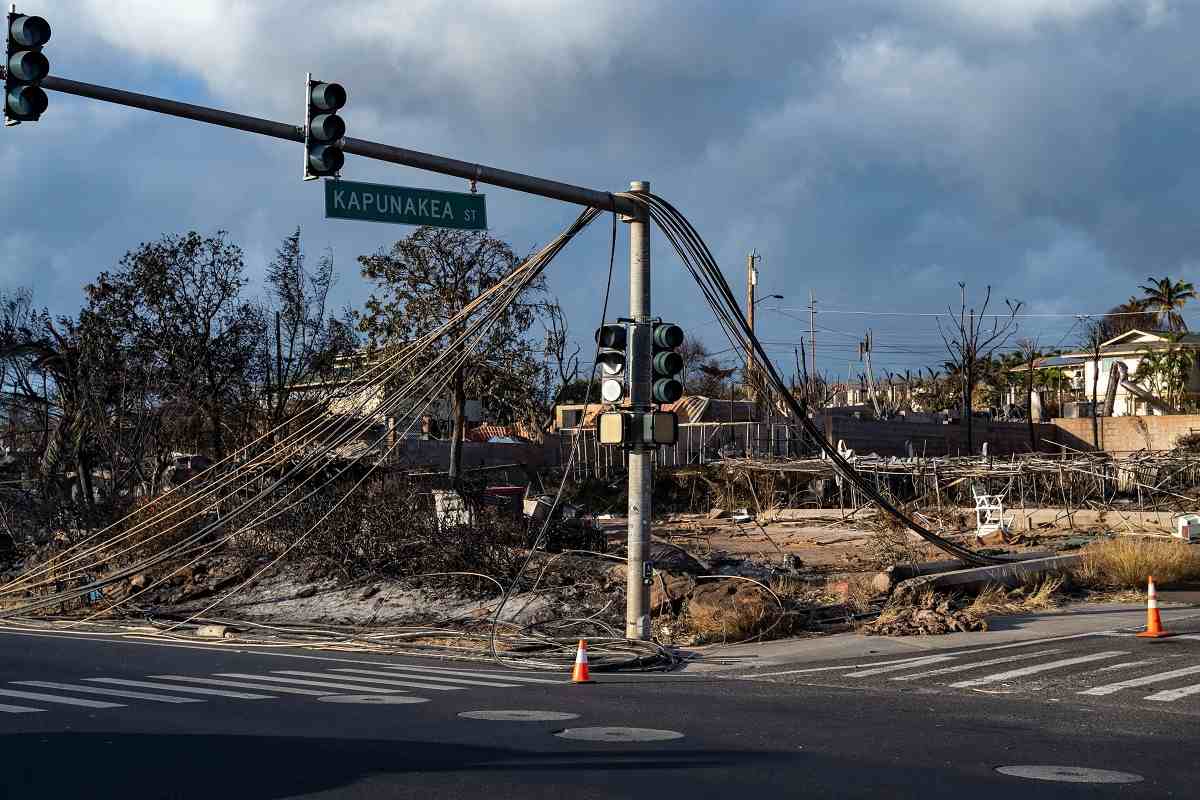
Fallen communications and power lines are seen Thursday after the wildfire tore through Kapunakea Street and Honoapiilani Highway in Lahaina, Hawaii.
17:52 JST, August 13, 2023
KIHEI, Hawaii – Four days before fast-moving brush fires engulfed parts of Maui, weather forecasters warned authorities that powerful wind gusts would trigger dangerous fire conditions across much of the island and Hawaii.
The state’s electric utility responded with some preemptive steps but did not use what is widely regarded as the most aggressive but effective safety measure: shutting down the power.
Hawaiian Electric, the utility that oversees Maui Electric and provides service to 95 percent of the state’s residents, did not deploy what’s known as a “public power shutoff plan,” which involves intentionally cutting off electricity to areas where big wind events could spark fires. A number of states, including California, have increasingly adopted this safety strategy after what were then the nation’s most destructive and deadliest fires, in 2017 and 2018.
Hawaiian Electric was aware that a power shut-off was an effective strategy, documents show, but had not adopted it as part of its fire mitigation plans, according to the company and two former power and energy officials interviewed by The Washington Post. Nor, in the face of predicted dangerous winds, did it act on its own, utility officials said, fearing uncertain consequences.
The decision to avoid shutting off power is reflective of the utility’s struggles to bolster its aging and vulnerable infrastructure against wildfires, said Jennifer Potter, who lives in Lahaina and was a member of the Hawaii Public Utilities Commission until just nine months ago.
“They were not as proactive as they should have been,” Potter said about Hawaiian Electric’s fire-prevention planning, adding that there had not been any real meaningful action to “address some of those inadequacies in terms of wildfire.”
Doug McLeod, a former energy commissioner for Maui County, also said the utility was aware of the need for a regular shut-down system and to bury lines, especially given the “number of close calls in the past.”
Earlier this week, high winds caused widespread damage to utility infrastructure. Photos and videos show power lines snapped in trees and swinging in the air. The intense gusts knocked down about 30 utility poles across the region, many onto trees and roads, complicating evacuations, according to Maui County Mayor Richard Bissen. He confirmed that some lines on the poles were energized when they hit the ground.
The cause of the Maui blazes – now the second-deadliest wildfire outbreak in modern U.S. history, with 80 people confirmed dead – remains under investigation. That probe may take weeks or even months to produce official findings, and on Friday, Hawaii Attorney General Anne Lopez (D) announced a “comprehensive review” of the decisions and policies surrounding the fires.
On Saturday, LippSmith LLP and other law firms filed a class-action lawsuit against the Hawaii utility, alleging that its downed power lines caused the fire, and that company officials “inexcusably kept their power lines energized” despite fire warnings.
Asked about its preparations and response, Hawaiian Electric rejected suggestions that it could have done more to protect public safety.
In a statement, the utility said it has a “robust wildfire mitigation and grid resiliency program” that includes managing vegetation, hardening its power systems and inspecting its infrastructure. It also said it followed protocols, including “not enabling the automatic reclosure of circuits that may open during a weather event.”
Such a procedure prevents a line from continuing to shower sparks after it has fallen, but does not prevent the initial spark, said Michael Wara, a wildfire expert who directs the Climate and Energy Policy Program at Stanford University. That’s the intent of a “public power shutoff plan,” a strategy with serious trade-offs.
Shutting down power is an agonizing decision for utility executives, since it disrupts lives and generates political blowback, especially if the anticipated wind event does not trigger fires. But as climate change intensifies extreme weather, shutting down power can prove to be a critical option for a utility to prevent destructive and deadly wildfires.
In California, Oregon, Nevada and other states, downed power lines, sparks from transmission hubs and other electrical-grid failures have started or helped to spread some of the deadliest and most destructive blazes in U.S. history. That has prompted utilities in these states, with approval from regulators, to proactively shut down power to communities when red-flag conditions arise.
Hawaiian Electric recognized that a power shut-off plan could be effective, especially after it reviewed what happened with California’s 2018 Camp Fire, which killed 85 people, documents show. In a filing to the state last year, it pointed to California’s Public Power Shutoff Plan as a successful way to prevent wildfires when additional robust techniques are not yet in place.
In its statement, however, Hawaiian Electric raised concerns that shutting off power might prevent fire crews from using electricity to draw water they needed for firefighting.
A utility spokesperson explained that it is difficult to enact “preemptive, short-notice power shutoffs” because they must be coordinated with first responders and that “notifications also need to be made to customers with special medical needs who use specialized equipment.”
Such challenges are a real concern, wildfire experts note, but they add that the purpose of a power shut-off plan is to ensure that advance arrangements are made with all parties affected. That includes emergency responders who, with enough time, can procure equipment such as backup generators to pump water if the grid goes down. Without such a plan, they said, such advance arrangements never will be in place.
In addition, Hawaii is powered by a grid that uses old wooden poles that are largely uninsulated and strung with lush vegetation over miles of rugged terrain, according to utility specialists. In interviews, residents and energy experts said they have long called for the utility to harden its grid, and despite the cost, to put more of it underground.
The poles have been in horrible shape for years, said Potter, the former utilities commissioner. “I think we were all playing on the fact that we got lucky – up until now,” she said.
Wara and other experts point out that before the Maui wildfires, there were no lightning strikes, a frequent cause of random fires in other parts of the United States. Instead, the pattern of Hawaii’s fires suggests that a spate of small ignitions combined to form a bigger blaze, Wara said, and “the only real source of that is power lines.”
The chronology of how and where the fires started, and when and where power equipment had problems, has alarmed many residents and officials.
Around 12:30 a.m. Tuesday, a brush fire started near Olinda Road in Kula, a small town in a mountainous region called Upcountry, near Maui’s highest peak. By that point, 80 mph gusts had caused power outages on other parts of the island.
Kyle Ellison, who lives in Kula, remembers looking out his bathroom window around 3 a.m. and seeing faint flames coming from Olinda Road. The winds, he recalled “were stronger than anything I’ve ever seen in my life and I’ve lived here 30 years.”
A few hours later, shortly after 5 a.m. Hawaiian Electric reported that crews were responding to outages around Lahaina, 30 miles away on the coast. Around 6:30 a.m., another brush fire broke out near Lahaina; officials contained that blaze.
By 9 a.m., thousands of people in Upcountry lost power “due to high winds,” the utility said on Twitter. “There are several spans of downed power lines in various areas that require repairs,” it wrote. “Mahalo for your patience.” At 9:45 a.m., the utility reported that it was inspecting three main transmission lines to check for damage and also was responding to repair “multiple downed poles and spans of lines in various areas.” Fire officials also warned that these downed lines “may be energized.”
Around 11:30 a.m., Ellison and his wife had just finished making chicken nuggets for their children when they heard a crack and a boom, what sounded like a tree going down “and something electrical.” He said his internet shut off and then, shortly after, flames were quickly crawling in the gulch behind his home. Grabbing their children and whatever items they could, the couple sprinted down the driveway and jumped into the car.
Photos from Hawaiian Electric on Twitter show wooden poles snapped in half and lines hanging or on the ground. One image was close to Ellison’s home, he said.
By late afternoon Tuesday, Ellison and more than 12,400 other people were without power, and about 30 downed poles and “multiple spans of power lines in various areas” across the island were in need of repair, the utility wrote.
The Lahaina Fire, which had been contained, again flared up. Shortly after, flames seized the town, consuming Front Street and jumping from building to building, forcing some residents to flee into the ocean.
When night fell, Ellison drove back up the hill to check on his house, which was miraculously still standing amid smoldering trees that were showering embers onto his roof. The fire had “gobbled up” many of the homes in his small, close-knit community.
The horrific scenes, stories of survival and shocking loss of life feel traumatically familiar to the moment that arguably changed how the nation thinks about wildfires and their potentially catastrophic impacts: The 2017 Tubbs Fire, when flames rushed over parched hillsides and jumped a freeway into the Northern California city of Santa Rosa in what felt like a matter of minutes, incinerating apartment complexes, out of which people narrowly escaped, and killing 22 people.
California would see this happen again and again, with the deadliest wildfire hitting the state just a year later. On a bone-dry, gusty day in November, the Camp Fire nearly incinerated the rural town of Paradise, again catching hundreds of residents by surprise and killing 85 people.
Ultimately it was a utility company, Pacific Gas & Electric, that was blamed for the Camp Fire, as well as several other major blazes, ignoring warnings from state officials about its aged equipment, inspections and other protocols. In 2020, PG&E, which has since filed for bankruptcy, pleaded guilty to involuntary manslaughter.
Like California and other western states, Hawaii is becoming more prone to wildfires, in part because of climate change but also because of other human-linked phenomena – such the spread of nonnative grasses, which become fuel for fires when they dry out.
In filings with the state, Hawaiian Electric has been detailing its goals to make its infrastructure more resilient. These include putting lines underground in vulnerable areas, hardening poles and launching a program to remove hazardous trees, according to grid assessment reports and funding applications to the Public Utilities Commission over the past few years.
It had closely studied California’s methodologies, including its Power Safety Shutoff (PSPS) Plan. Hawaiian Electric cited it as a strategy that helps mitigate “wildfire risks until more robust preventive measures have been implemented in an area.”
The utility also took notice of California’s faults, documents show, having considered the state’s “devastating wildfires of 2018,” as well as its own experiences in 2019. It noted that utility companies can be held liable when it comes to sparking or spreading a wildfire, and cited PG&E’s $15 billion settlement with victims as an example.
“The risk of a utility system causing a wildfire ignition is significant,” the company wrote last summer. As a result, it wanted to take the adequate steps to ensure that its facilities would not be “the origin or contributing source of ignition for a wildfire.”
"News Services" POPULAR ARTICLE
-

American Playwright Jeremy O. Harris Arrested in Japan on Alleged Drug Smuggling
-

Taiwan President Shows Support for Japan in China Dispute with Sushi Lunch
-

Japan’s Nikkei Stock Average as JGB Yields, Yen Rise on Rate-Hike Bets
-

Japan’s Nikkei Stock Average Licks Wounds after Selloff Sparked by BOJ Hike Bets (UPDATE 1)
-

Japanese Bond Yields Zoom, Stocks Slide as Rate Hike Looms
JN ACCESS RANKING
-

Japan’s Hopes for Seafood Exports Shot Down in China Spat
-

Keidanren Chairman Yoshinobu Tsutsui Visits Kashiwazaki-Kariwa Nuclear Power Plant; Inspects New Emergency Safety System
-

Japan to Charge Foreigners More for Residence Permits, Looking to Align with Western Countries
-

Imports of Rare Earths from China Facing Delays, May Be Caused by Deterioration of Japan-China Relations
-

Japan Exports Rise in October as Slump in U.S. Sales Eases

























